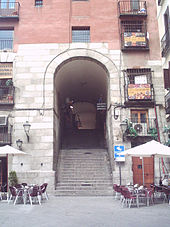Plaza Mayor (Madrid)
The Plaza Mayor (German main square ) is located in the center of Madrid , the Spanish capital, only a few meters from the Puerta del Sol and the Plaza de la Villa , directly on the Calle Mayor .
space

It is a rectangular square (129 meters long and 94 meters wide) that is completely surrounded by four-story residential buildings. These have a total of 237 balconies, all of which are on the side of the square. The square has nine entrances, the most famous of which is the so-called Arco de Cuchilleros (" Knife Sharpener's Bow"), which is located on the south-western corner. In the middle of the north side of the square rises the Casa de la Panadería ("House of the Bakery") - probably the oldest and most famous building in the square; Opposite it, on the south side, is the Casa de la Carnicería ("House of the Butcher's") , built a little later . Under the arcades that run around the square and are supported by granite pillars, there are numerous restaurants and bars, as the square is one of the most famous tourist destinations in Madrid. There are also shops in the field of philately and numismatics .
history
The origins of the Plaza Mayor go back to the 15th century. At that time, Calle de Toledo and Calle de Atocha converged in front of the medieval city, and the city's main market was held in this place, which was then called Plaza del Arrabal . At this time the first house with a portico was built; it was also a commodity exchange to regulate trade in the market. In 1580, after the royal court had moved to Madrid in 1561, Philip II commissioned the architect Juan de Herrera to remodel the square. First the so-called casas de manzanas ("apple houses") of the old square were torn down. Construction of the first building on the new square, the Casa de la Panadería , may have started in 1590 on the site of the former commodity exchange. In 1610 or 1617, Philip III commissioned the architect Juan Gómez de Mora with the completion of the square, which he accomplished by 1619.
The Plaza Mayor has suffered three major fires in its history - the first in 1631, when Juan Gómez de Mora undertook the reconstruction work. The second major fire occurred in 1672 - this time the architect Tomás Román took over the reconstruction work . The last and worst fire in 1790 destroyed a third of the entire square - only the Casa de la Panadería was spared this time. The reconstruction was led by Juan de Villanueva, the architect of the Prado, who reduced the height of the houses surrounding the square from six to four storeys. The reconstruction lasted until 1854 and was completed after the death of Villanueva by his two students Antonio López Aguado and Custodio Moreno.
In 1848 the equestrian statue was finally erected in honor of Philip III. placed in the middle of the square. It is the work of Pietro Tacca , a pupil of Giambologna , and was begun in 1616.
In 1880 the Casa de la Panadería was restored. A minor modification was made in 1935. But it was not until the 1960s that the square was completely restored; the square was closed to rolling traffic and a parking garage was built under the square. The last work lasted until 1992. The current wall decoration was attached to the Casa de la Panadería , depicting mythological people such as B. shows the goddess Cybele ( Cibeles ).
Names
The name of the square has changed several times in its history. The original name was Plaza del Arrabal . Later it was called Plaza Mayor ("main square"). In 1812, during the Spanish War of Independence (1807-1814), all Plazas Mayores in Spain had to rename themselves to Plaza de la Constitución (" Constitution Square") due to a royal decree . However, this requirement only applied to the Plaza Mayor in Madrid for two years. In 1814 the Plaza Mayor was renamed “Plaza Real” (“Königsplatz”). Later it was called Plaza de la Constitución again from 1820 to 1823, from 1833 to 1835 and from 1840 to 1843.
In 1873 the square was renamed Plaza de la República and since the installation of Alfonso XII. Renamed again in 1876 to Plaza de la Constitución . So it was called until the dictatorship of Primo de Rivera in 1923. From the proclamation of the Second Spanish Republic until the end of the Spanish Civil War it was called Plaza de la Constitución . Only then did it regain its old name Plaza Mayor , which it still bears today.
function
In the course of history, the Plaza Mayor was used for a variety of purposes - this included markets, bullfights , football games, theater performances, public exhibitions and - during the Spanish Inquisition - also the so-called auto-dafe against alleged heretics as well as their public punishment (mostly fire at the stake ). The celebrations in honor of San Isidro , the patron saint of Madrid, also take place in the Plaza Mayor. Nowadays the square is a top attraction and is visited by hundreds of thousands of tourists every year. In December, the traditional Christmas market takes place here - a custom that has been practiced in Madrid since 1860.
See also
literature
- Wolfgang Braunfels : Occidental city architecture. Form of rule and structure. 6th edition DuMont, Cologne 1991, ISBN 3-7701-0882-5 (EA Cologne 1976).
- Heinz Coubier : European city squares. Genius and history. DuMont, Cologne 1985, ISBN 3-7701-1266-0 .
Web links
Coordinates: 40 ° 24 ′ 56 " N , 3 ° 42 ′ 27" W.



